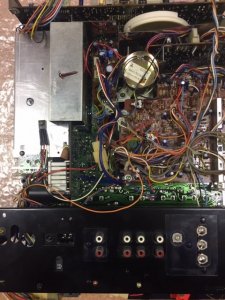Sorry guys - no pretty "ooh-aah" pictures here. 
I wanted to post this just to give everyone an idea as to what's going on inside this behemoth. It's not mine - I'm repairing it for a friend and fellow member. I wanted to know what I'd be in for if I took the project on, but I couldn't find anything other than nice pics of complete units. That's why I'm posting this.
I would not recomend digging too deep into this thing without the service manual, since it's pretty much "visual chaos" once it's removed from the back case. It had several issues, including noise, an unreliable left channel, static everywhere, erratic VU's, a sticky source attenuator slider, and a few other odds and ends, not to mention the tuner which is a whole other issue.
I stripped it down to the sheet metal (yes, sheet metal). It needed a re-cap, about 60+/- re-flowed solder joints (someone got into this thing), a small crack in the main board...I won't bore you with the laundry list.
Anyhoo, here's what it looks like inside at various states of disassembly. Unfortunately, I was more concerned with the work at hand than taking pictures, so they are not very comprhensive. But they should give everyone a good idea of the build quality and ease (or lack thereof) of service.:
Here's the back of the unit, removed from the back case with the faceplate removed and close at hand for reference.:
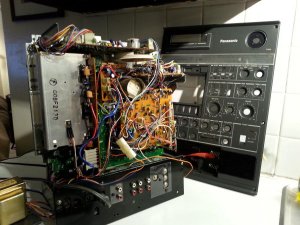
Here, you can see a small crack in the corner of the main board. It's very solid when fully assembled, so I'm willing to bet this was caused by hasty service.:
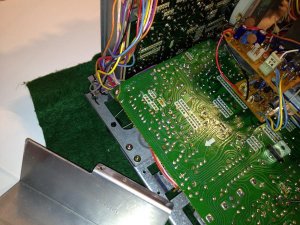
This small board for the motor speed control was the guilty party responsible for the erratic VU's. It's mounted to the deck chassis with a nylon screw and nut that had failed, causing it to make contact with the VU switch.:
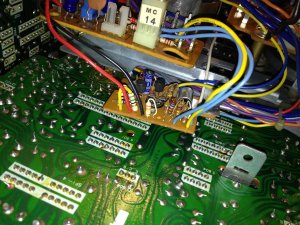
Here you can see the back of the unit with all but the main board freed from the chassis, so I could get a good look at the back side of the main board. This is why I refer to it as "The Steel Octopus." :
:
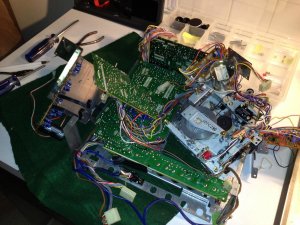
And, finally, here is the front of the unit, minus the faceplate. I never would have been able to remove it without the service manual - not in a million years. You'll notice the whole chassis system is sheet steel through and through.:
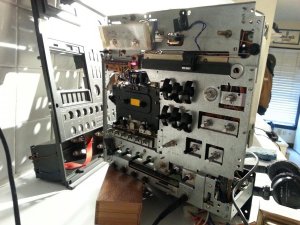
I'm just about wrapped up with this project, and I've gotta say - It's been very rewarding to ween this unit off life support. I love the Tape Speed Control and the Source Attenuator (very cool feature). Deck is rock-solid and it drives my Toby D-60's with the greatest of ease. It's gonna be hard to let it go back to it's rightful owner, but it's a loving home and I have been happy to help.
Back to it tomorrow, but for today....Happy Thanksgiving!
I hope this thread gives members an idea as to what exactly it's like to dig into this monster.

I wanted to post this just to give everyone an idea as to what's going on inside this behemoth. It's not mine - I'm repairing it for a friend and fellow member. I wanted to know what I'd be in for if I took the project on, but I couldn't find anything other than nice pics of complete units. That's why I'm posting this.
I would not recomend digging too deep into this thing without the service manual, since it's pretty much "visual chaos" once it's removed from the back case. It had several issues, including noise, an unreliable left channel, static everywhere, erratic VU's, a sticky source attenuator slider, and a few other odds and ends, not to mention the tuner which is a whole other issue.
I stripped it down to the sheet metal (yes, sheet metal). It needed a re-cap, about 60+/- re-flowed solder joints (someone got into this thing), a small crack in the main board...I won't bore you with the laundry list.
Anyhoo, here's what it looks like inside at various states of disassembly. Unfortunately, I was more concerned with the work at hand than taking pictures, so they are not very comprhensive. But they should give everyone a good idea of the build quality and ease (or lack thereof) of service.:
Here's the back of the unit, removed from the back case with the faceplate removed and close at hand for reference.:

Here, you can see a small crack in the corner of the main board. It's very solid when fully assembled, so I'm willing to bet this was caused by hasty service.:

This small board for the motor speed control was the guilty party responsible for the erratic VU's. It's mounted to the deck chassis with a nylon screw and nut that had failed, causing it to make contact with the VU switch.:

Here you can see the back of the unit with all but the main board freed from the chassis, so I could get a good look at the back side of the main board. This is why I refer to it as "The Steel Octopus."
 :
:
And, finally, here is the front of the unit, minus the faceplate. I never would have been able to remove it without the service manual - not in a million years. You'll notice the whole chassis system is sheet steel through and through.:

I'm just about wrapped up with this project, and I've gotta say - It's been very rewarding to ween this unit off life support. I love the Tape Speed Control and the Source Attenuator (very cool feature). Deck is rock-solid and it drives my Toby D-60's with the greatest of ease. It's gonna be hard to let it go back to it's rightful owner, but it's a loving home and I have been happy to help.
Back to it tomorrow, but for today....Happy Thanksgiving!
I hope this thread gives members an idea as to what exactly it's like to dig into this monster.









